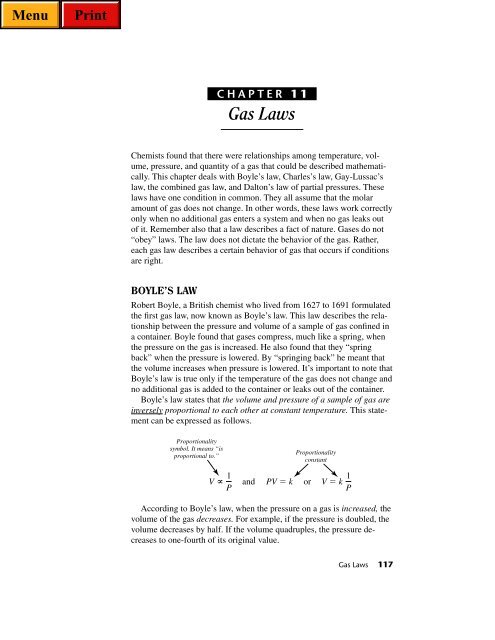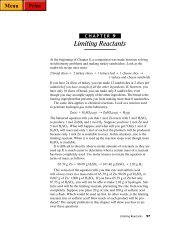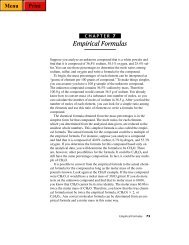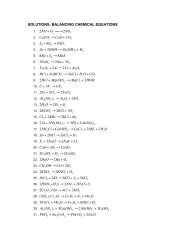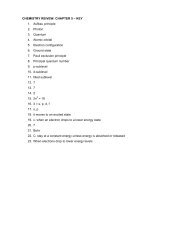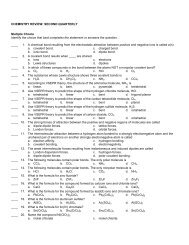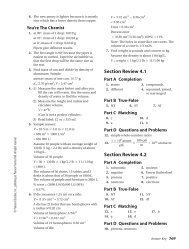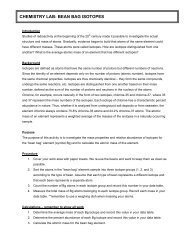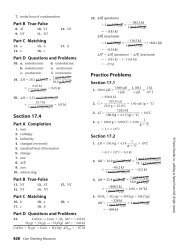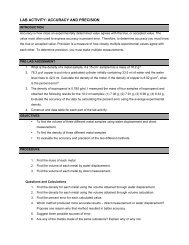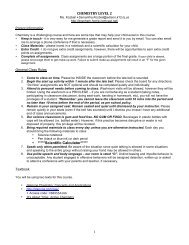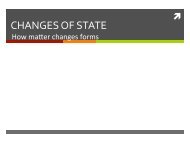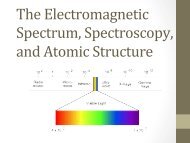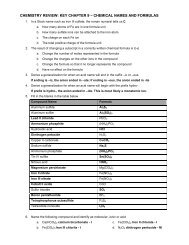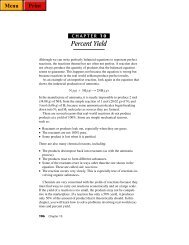Gas Laws
Gas Laws
Gas Laws
You also want an ePaper? Increase the reach of your titles
YUMPU automatically turns print PDFs into web optimized ePapers that Google loves.
CHAPTER 11<br />
<strong>Gas</strong> <strong>Laws</strong><br />
Chemists found that there were relationships among temperature, volume,<br />
pressure, and quantity of a gas that could be described mathematically.<br />
This chapter deals with Boyle’s law, Charles’s law, Gay-Lussac’s<br />
law, the combined gas law, and Dalton’s law of partial pressures. These<br />
laws have one condition in common. They all assume that the molar<br />
amount of gas does not change. In other words, these laws work correctly<br />
only when no additional gas enters a system and when no gas leaks out<br />
of it. Remember also that a law describes a fact of nature. <strong>Gas</strong>es do not<br />
“obey” laws. The law does not dictate the behavior of the gas. Rather,<br />
each gas law describes a certain behavior of gas that occurs if conditions<br />
are right.<br />
BOYLE’S LAW<br />
Robert Boyle, a British chemist who lived from 1627 to 1691 formulated<br />
the first gas law, now known as Boyle’s law. This law describes the relationship<br />
between the pressure and volume of a sample of gas confined in<br />
a container. Boyle found that gases compress, much like a spring, when<br />
the pressure on the gas is increased. He also found that they “spring<br />
back” when the pressure is lowered. By “springing back” he meant that<br />
the volume increases when pressure is lowered. It’s important to note that<br />
Boyle’s law is true only if the temperature of the gas does not change and<br />
no additional gas is added to the container or leaks out of the container.<br />
Boyle’s law states that the volume and pressure of a sample of gas are<br />
inversely proportional to each other at constant temperature. This statement<br />
can be expressed as follows.<br />
Proportionality<br />
symbol. It means “is<br />
proportional to.”<br />
V 1<br />
P and<br />
Proportionality<br />
constant<br />
PV k or V k<br />
According to Boyle’s law, when the pressure on a gas is increased, the<br />
volume of the gas decreases. For example, if the pressure is doubled, the<br />
volume decreases by half. If the volume quadruples, the pressure decreases<br />
to one-fourth of its original value.<br />
1<br />
P<br />
<strong>Gas</strong> <strong>Laws</strong> 117
The expression PV k means that the product of the pressure and<br />
volume of any sample of gas is a constant, k. If this is true, then P V<br />
under one set of conditions is equal to P V for the same sample of gas<br />
under a second set of conditions, as long as the temperature remains<br />
constant.<br />
Boyle’s law can be expressed by the following mathematical equation.<br />
Pressure under<br />
the first set of<br />
conditions<br />
118 Chapter 11<br />
General Plan for Solving Boyle's-Law Problems<br />
2<br />
<br />
Volume under<br />
the first set of<br />
conditions<br />
1<br />
Given three of the following<br />
four quantities:<br />
P 1 , V 1 , P 2 , V 2<br />
Rearrange the equation<br />
P 1 V 1 P 2 V 2<br />
algebraically to solve for<br />
the unknown quantity.<br />
An equation that can be used to<br />
calculate the unknown quantity<br />
It will be one of the following four:<br />
P1V1 P1V1 P2V2 V2 , P2 , V1 , P1 <br />
P 2<br />
P 1 V 1 P 2 V 2<br />
3<br />
V 2<br />
<br />
Substitute each of the<br />
known quantities,<br />
and calculate.<br />
Unknown<br />
P or V<br />
Pressure under<br />
the second set<br />
of conditions<br />
P 1<br />
Volume under<br />
the second set<br />
of conditions<br />
P 2 V 2<br />
V 1
SAMPLE PROBLEM 1<br />
A sample of nitrogen collected in the laboratory occupies a<br />
volume of 725 mL at a pressure of 0.971 atm. What volume<br />
will the gas occupy at a pressure of 1.40 atm, assuming the<br />
temperature remains constant?<br />
SOLUTION<br />
1. ANALYZE<br />
• What is given in the the original volume and pressure of<br />
problem? the nitrogen sample, and the new<br />
pressure of the sample<br />
• What are you asked to find? the volume at the new pressure<br />
Items Data<br />
Original pressure, P 1<br />
Original volume, V 1<br />
New pressure, P 2<br />
New volume, V 2<br />
0.971 atm<br />
725 mL N 2<br />
1.40 atm<br />
? mL N 2<br />
2. PLAN<br />
• What steps are needed to Rearrange the Boyle’s law equation<br />
calculate the new volume of to solve for V 2, substitute known<br />
the gas? quantities, and calculate.<br />
1<br />
P1V1 P2V2 to solve for V2 ,<br />
divide both sides of<br />
the equation by P2 to<br />
isolate V2 insert data and solve for V2 2<br />
P1V1 V2 <br />
P2 3. COMPUTE<br />
Substitute data for the terms of the equation, and compute the result.<br />
V 2 P 1V 1<br />
P 2<br />
0.971 atm 725 mL N 2<br />
1.40 atm<br />
503 mL N 2<br />
4. EVALUATE<br />
• Are the units correct? Yes; units canceled to give mL N2. • Is the number of significant Yes; the number of significant figfigures<br />
correct? ures is correct because data were<br />
given to three significant figures.<br />
• Is the answer reasonable? Yes; pressure increased by about 1/3,<br />
volume must decrease by about 1/3.<br />
<strong>Gas</strong> <strong>Laws</strong> 119
PRACTICE<br />
In each of the following problems, assume that the temperature and molar<br />
quantity of gas do not change.<br />
1. Calculate the unknown quantity in each of the following measurements<br />
of gases.<br />
P 1 V 1 P 2 V 2<br />
a. 3.0 atm 25 mL 6.0 atm ? mL<br />
b. 99.97 kPa 550. mL ? kPa 275 mL<br />
c. 0.89 atm ? L 3.56 atm 20.0 L<br />
d. ? kPa 800. mL 500. kPa 160. mL<br />
e. 0.040 atm ? L 250 atm 1.0 10 2 L<br />
2. A sample of neon gas occupies a volume of 2.8 L<br />
at 1.8 atm. What will its volume be at 1.2 atm? ans: 4.2 L<br />
3. To what pressure would you have to compress<br />
48.0 L of oxygen gas at 99.3 kPa in order to reduce<br />
its volume to 16.0 L? ans: 298 kPa<br />
4. A chemist collects 59.0 mL of sulfur dioxide gas<br />
on a day when the atmospheric pressure is<br />
0.989 atm. On the next day, the pressure has<br />
changed to 0.967 atm. What will the volume of<br />
the SO2 gas be on the second day? ans: 60.3 mL<br />
5. 2.2 L of hydrogen at 6.5 atm pressure is used<br />
to fill a balloon at a final pressure of 1.15 atm.<br />
What is its final volume? ans: 12 L<br />
CHARLES’S LAW<br />
The French physicist Jacques Charles carried out experiments in 1786<br />
and 1787 that showed a relationship between the temperature and volume<br />
of gases at constant pressure. You know that most matter expands as its<br />
temperature rises. <strong>Gas</strong>es are no different. When Benjamin Thomson and<br />
Lord Kelvin proposed an absolute temperature scale in 1848, it was possible<br />
to set up the mathematical expression of Charles’s law.<br />
Charles’s law states that the volume of a sample of gas is directly proportional<br />
to the absolute temperature when pressure remains constant.<br />
Charles’s law can be expressed as follows.<br />
V T and V<br />
k, or V kT<br />
T<br />
120 Chapter 11<br />
ans: 13 mL<br />
ans: 200. kPa<br />
ans: 80. L<br />
ans: 100. kPa<br />
ans: 63 L
According to Charles’s law, when the temperature of a sample of gas increases,<br />
the volume of the gas increases by the same factor. Therefore,<br />
doubling the Kelvin temperature of a gas will double its volume. Reducing<br />
the Kelvin temperature by 25% will reduce the volume by 25%.<br />
The expression V/T k means that the result of volume divided by<br />
temperature is a constant, k, for any sample of gas. If this is true, then V/T<br />
under one set of conditions is equal to V/T for the same sample of gas under<br />
another set of conditions, as long as the pressure remains constant.<br />
Charles’s law can be expressed by the following mathematical equation.<br />
V1 T1 V 2<br />
T 2<br />
General Plan for Solving Charles’s-Law Problems<br />
1<br />
Convert Celsius<br />
temperatures to<br />
Kelvin temperatures<br />
if necessary.<br />
Given three of the following<br />
four quantities:<br />
T 1 , V 1 , T 2 , V 2<br />
Rearrange the equation<br />
V1 T1 <br />
algebraically to solve for<br />
the unknown quantity.<br />
2<br />
An equation that can be used to<br />
calculate the unknown quantity<br />
It will be one of the following four:<br />
T2V1 T1V2 T1V2 T2V1 V2 , T2 , V1 , T1 <br />
T1 V1 T2 V2 3<br />
Unknown<br />
T or V<br />
V2 T2 Substitute each of the<br />
known quantities,<br />
and compute.<br />
Convert<br />
K to C if<br />
needed.<br />
Unknown<br />
t in C<br />
<strong>Gas</strong> <strong>Laws</strong> 121
SAMPLE PROBLEM 2<br />
A container of oxygen has a volume of 349 mL at a temperature<br />
of 22°C. What volume will the gas occupy at 50.°C?<br />
SOLUTION<br />
1. ANALYZE<br />
• What is given in the the original volume and temperaproblem?<br />
ture of the oxygen sample, and the<br />
new temperature of the sample<br />
• What are you asked to find? the volume at the new temperature<br />
Items Data<br />
Original volume, V 1<br />
Original temperature, t 1<br />
Original Kelvin temperature, T 1<br />
New volume, V 2<br />
New temperature, t 2<br />
New Kelvin temperature, T 2<br />
2. PLAN<br />
• What steps are needed to Rearrange the Charles’s law equacalculate<br />
the new volume tion to solve for V 2, substitute<br />
of the gas? known quantities, and calculate.<br />
V 1<br />
T 1<br />
122 Chapter 11<br />
1<br />
<br />
V2 T2 349 mL O 2<br />
22°C<br />
(22 273) K 295 K<br />
? mL O 2<br />
50.°C<br />
to solve for V2 ,<br />
multiply both sides of<br />
the equation by T2 to<br />
isolate V2 insert data and solve for V2 (50. 273) K 323 K<br />
V 1 T 2<br />
T 1<br />
2<br />
V 2<br />
3. COMPUTE<br />
Substitute data for the terms of the equation, and compute the result.<br />
V 2 V 1T 2<br />
T 1<br />
349 mL O 2 323 K<br />
295 K<br />
382 mL O 2<br />
4. EVALUATE<br />
• Are the units correct? Yes; units canceled to give mL O2. • Is the number of significant Yes; the number of significant figfigures<br />
correct? ures is correct because data were<br />
given to three significant figures.<br />
• Is the answer reasonable? Yes; the temperature increased, so<br />
the volume must also increase.
PRACTICE<br />
In each of the following problems, assume that the pressure and molar<br />
quantity of gas do not change.<br />
1. Calculate the unknown quantity in each of the following measurements<br />
of gases.<br />
V 1 T 1 V 2 T 2<br />
a. 40.0 mL 280. K ? mL 350. K<br />
b. 0.606 L 300. K 0.404 L ? K<br />
c. ? mL 292 K 250. mL 365 K<br />
d. 100. mL ? K 125 mL 305 K<br />
e. 0.0024 L 22°C ? L 14°C<br />
ans: 50.0 mL<br />
ans: 200. K<br />
ans: 200. mL<br />
ans: 244 K<br />
ans: 0.0021 L<br />
2. A balloon full of air has a volume of 2.75 L<br />
at a temperature of 18°C. What is the balloon’s<br />
volume at 45°C? ans: 3.01 L<br />
3. A sample of argon has a volume of 0.43 mL at 24°C.<br />
At what temperature in degrees Celsius will it have<br />
a volume of 0.57 mL? ans: 121°C<br />
GAY-LUSSAC’S LAW<br />
You may have noticed a warning on an aerosol spray can that says something<br />
similar to Do not incinerate! Do not expose to temperatures greater<br />
than 140°F! Warnings such as this appear because the pressure of a confined<br />
gas increases with increasing temperature. If the temperature of the<br />
can increases enough, the can will explode because of the pressure that<br />
builds up inside of it.<br />
The relationship between the pressure and temperature of a gas is described<br />
by Gay-Lussac’s law. Gay-Lussac’s law states that the pressure of<br />
a sample of gas is directly proportional to the absolute temperature when<br />
volume remains constant. Gay-Lussac’s law can be expressed as follows.<br />
P T and P<br />
T<br />
k, or P kT<br />
According to Gay-Lussac’s law, when the temperature of a sample of<br />
gas increases, the pressure of the gas increases by the same factor. Therefore,<br />
doubling the temperature of a gas will double its pressure. Reducing<br />
the temperature of a gas to 75% of its original value will also reduce the<br />
pressure to 75% of its original value.<br />
<strong>Gas</strong> <strong>Laws</strong> 123
The expression P/T k means that the result of pressure divided by<br />
temperature is a constant, k, for any sample of gas. If this is true, then<br />
P/T under one set of conditions is equal to P/T for the same sample of<br />
gas under another set of conditions, as long as the volume remains<br />
constant.<br />
Gay-Lussac’s law can be expressed by the following mathematical<br />
equation.<br />
124 Chapter 11<br />
P1 T1 P 2<br />
T 2<br />
General Plan for Solving Gay-Lussac’s-Law Problems<br />
1<br />
Given three of the following<br />
four quantities:<br />
T 1 , P 1 , T 2 , P 2<br />
Rearrange the equation<br />
P1 T1 <br />
algebraically to solve for<br />
the unknown quantity.<br />
2<br />
An equation that can be used to<br />
calculate the unknown quantity<br />
It will be one of the following four:<br />
T2P1 P2 ,<br />
T1 T1P2 T2 ,<br />
P1 T1P2 P1 ,<br />
T2 T2P1 T1 <br />
P2 Convert Celsius<br />
temperatures to<br />
Kelvin temperatures<br />
if necessary.<br />
3<br />
Unknown<br />
T or P<br />
P2 T2 Substitute each of the<br />
known quantities,<br />
and compute.<br />
Convert<br />
K to C if<br />
needed.<br />
Unknown<br />
t in C
SAMPLE PROBLEM 3<br />
A cylinder of gas has a pressure of 4.40 atm at 25°C. At what<br />
temperature in °C will it reach a pressure of 6.50 atm?<br />
SOLUTION<br />
1. ANALYZE<br />
• What is given in the the original pressure and temperaproblem?<br />
ture of the gas in the cylinder, and<br />
the new pressure of the sample<br />
• What are you asked to find? the temperature at which the gas<br />
reaches the specified pressure<br />
Items Data<br />
Original pressure, P 1<br />
Original temperature, t 1<br />
Original Kelvin temperature, T 1<br />
New pressure, P 2<br />
New temperature, t 2<br />
New Kelvin temperature, T 2<br />
4.40 atm<br />
25°C<br />
(25 273) K 298 K<br />
6.50 atm<br />
2. PLAN<br />
• What steps are needed to Rearrange the Gay-Lussac’s law<br />
calculate the new tempera- equation to solve for T 2, substitute<br />
ture of the gas? known quantities, and calculate.<br />
1<br />
P1 P2 <br />
T1 T2 to solve for T2 , divide<br />
both sides of the equation<br />
by P2 and invert the<br />
equality to isolate T2 insert data and solve for T2 ?°C<br />
? K<br />
T 1 P 2<br />
P 1<br />
2<br />
T 2<br />
3. COMPUTE<br />
Substitute data for the terms of the equation, and compute the result.<br />
T 2 T 1P 2<br />
P 1<br />
<br />
298 K 6.50 atm<br />
4.40 atm<br />
440. K<br />
Convert back to °C.<br />
440. K (440. 273)°C 167°C<br />
4. EVALUATE<br />
• Are the units correct? Yes; units canceled to give Kelvin<br />
temperature, which was converted<br />
to °C.<br />
<strong>Gas</strong> <strong>Laws</strong> 125
• Is the number of significant Yes; the number of significant figfigures<br />
correct? ures is correct because the data were<br />
given to three significant figures.<br />
• Is the answer reasonable? Yes; the pressure increases, so the<br />
temperature must also increase.<br />
PRACTICE<br />
In each of the following problems, assume that the volume and molar<br />
quantity of gas do not change.<br />
1. Calculate the unknown quantity in each of the following measurements<br />
of gases:<br />
P 1 T 1 P 2 T 2<br />
a. 1.50 atm 273 K ? atm 410 K<br />
b. 0.208 atm 300. K 0.156 atm ? K<br />
c. ? kPa 52°C 99.7 kPa 77°C<br />
d. 5.20 atm ?°C 4.16 atm 13°C<br />
e. 8.33 104 84°C 3.92 103 ? °C<br />
atm atm<br />
126 Chapter 11<br />
ans: 2.25 atm<br />
ans: 225 K<br />
ans: 92.6 kPa<br />
ans: 52°C<br />
ans: 616°C<br />
2. A cylinder of compressed gas has a pressure of<br />
4.882 atm on one day. The next day, the same<br />
cylinder of gas has a pressure of 4.690 atm, and<br />
its temperature is 8°C. What was the temperature<br />
on the previous day in °C? ans: 20.°C<br />
3. A mylar balloon is filled with helium gas to a<br />
pressure of 107 kPa when the temperature is<br />
22°C. If the temperature changes to 45°C, what<br />
will be the pressure of the helium in the balloon? ans: 115 kPa<br />
THE COMBINED GAS LAW<br />
Look at the relationships among temperature, volume, and pressure of a<br />
gas that you have studied so far.<br />
Boyle’s law<br />
At constant<br />
temperature:<br />
PV k<br />
Charles’s law<br />
At constant pressure:<br />
V<br />
k<br />
T<br />
Gay-Lussac’s law<br />
At constant volume:<br />
P<br />
k<br />
T<br />
Notice in these proportions that while P and V are inversely proportional<br />
to each other, they are each directly proportional to temperature.
These three gas laws can be combined in one combined gas law. This law<br />
can be expressed as follows.<br />
If PV/T equals a constant, k, then PV/T for a sample of gas under one<br />
set of conditions equals PV/T under another set of conditions, assuming<br />
the amount of gas remains the same.<br />
Therefore, the combined gas law can be expressed by the following<br />
mathematical equation. This equation can be used to solve problems in<br />
which pressure, volume, and temperature of a gas vary. Only the molar<br />
quantity of the gas must be constant.<br />
General Plan for Solving Combined-<strong>Gas</strong>-Law Problems<br />
2<br />
1<br />
Convert Celsius<br />
temperatures to<br />
Kelvin temperatures<br />
if necessary.<br />
P 1V 1<br />
T 1<br />
Given five of the following<br />
six quantities:<br />
V 1 ,T 1 , P 1 , V 2 ,T 2 , P 2<br />
Rearrange the equation<br />
P1V1 P2V2 <br />
T1 T2 algebraically to solve for<br />
the unknown quantity.<br />
An equation that can be used to<br />
calculate the unknown quantity<br />
3<br />
PV<br />
T<br />
k<br />
P 2V 2<br />
T 2<br />
Unknown<br />
V, T, or P<br />
Substitute each of the<br />
known quantities,<br />
and compute.<br />
Convert<br />
K to C if<br />
needed.<br />
Unknown<br />
t in C<br />
<strong>Gas</strong> <strong>Laws</strong> 127
SAMPLE PROBLEM 4<br />
A sample of hydrogen gas has a volume of 65.0 mL at a pressure<br />
of 0.992 atm and a temperature of 16°C. What volume<br />
will the hydrogen occupy at 0.984 atm and 25°C?<br />
SOLUTION<br />
1. ANALYZE<br />
• What is given in the the original volume, pressure, and<br />
problem? temperature of the hydrogen, and<br />
the new pressure and temperature of<br />
the hydrogen<br />
• What are you asked to find? the volume at the new temperature<br />
and pressure<br />
Items Data<br />
Original volume, V 1<br />
Original pressure, P 1<br />
Original temperature, t 1<br />
Original Kelvin temperature, T 1<br />
New volume, V 2<br />
New pressure, P 2<br />
New temperature, t 2<br />
New Kelvin temperature, T 2<br />
2. PLAN<br />
• What steps are needed to Rearrange the combined gas law<br />
calculate the new volume of equation to solve for V 2, substitute<br />
the gas? known quantities, and calculate.<br />
128 Chapter 11<br />
1<br />
P1V1 <br />
T1 P 2 V 2<br />
T 2<br />
to solve for V2 ,<br />
multiply both sides of<br />
the equation by T2 /P2 to<br />
isolate V2 insert data and solve for V2 65.0 mL<br />
0.992 atm<br />
16°C<br />
(16 273) K 289 K<br />
? mL<br />
0.984 atm<br />
25°C<br />
(25 273) K 298 K<br />
2<br />
T2P1V1 V2 P2T1 3. COMPUTE<br />
Substitute data for the terms of the equation, and compute the result.<br />
V 2 T 2P 1V 1<br />
P 2T 1<br />
298 K 0.992 atm 65.0 mL H 2<br />
0.984 atm 289 K<br />
67.6 mL H 2
4. EVALUATE<br />
• Are the units correct? Yes; units canceled to give mL of H2. • Is the number of significant Yes; the number of significant figfigures<br />
correct? ures is correct because data were<br />
given to three significant figures.<br />
• Is the answer reasonable? Yes; the temperature increases, and<br />
the pressure decreases, both of<br />
which have the effect of making the<br />
volume larger.<br />
PRACTICE<br />
In each of the following problems, it is assumed that the molar quantity<br />
of gas does not change.<br />
1. Calculate the unknown quantity in each of the following measurements<br />
of gases.<br />
P 1 V 1 T 1 P 2 V 2 T 2<br />
a. 99.3 225 mL 15°C 102.8 ? mL 24°C<br />
kPa kPa<br />
b. 0.959<br />
atm<br />
3.50 L 45°C ? atm 3.70 L 37°C<br />
c. 0.0036 62 mL 373 K 0.0029 64 mL ? K<br />
atm atm<br />
d. 100. 43.2 mL 19°C 101.3 ? mL 0°C<br />
kPa kPa<br />
2. A student collects 450. mL of HCl(g) hydrogen chloride<br />
gas at a pressure of 100. kPa and a temperature<br />
of 17°C. What is the volume of the HCl at 0°C and<br />
101.3 kPa? ans: 418 mL<br />
DALTON’S LAW OF PARTIAL PRESSURES<br />
ans: 224 mL<br />
ans: 0.884 atm<br />
ans: 310 K<br />
ans: 39.9 mL<br />
Air is a mixture of approximately 78% N2, 20% O2, 1% Ar, and 1%<br />
other gases by volume, so at any barometric pressure 78% of that pressure<br />
is exerted by nitrogen, 20% by oxygen, and so on. This phenomenon<br />
is described by Dalton’s law of partial pressures, which says that the total<br />
pressure of a mixture of gases is equal to the sum of the partial pressures<br />
of the component gases. It can be stated mathematically as follows.<br />
PTotal P<strong>Gas</strong> 1 P<strong>Gas</strong> 2 P<strong>Gas</strong> 3 P<strong>Gas</strong> 4 …<br />
<strong>Gas</strong> <strong>Laws</strong> 129
A common method of collecting gas samples in the laboratory is to<br />
bubble the gas into a bottle filled with water and allow it to displace the<br />
water. When this technique is used, however, the gas collected in the bottle<br />
contains a small but significant amount of water vapor. As a result, the<br />
pressure of the gas that has displaced the liquid water is the sum of the<br />
pressure of the gas plus the vapor pressure of water at that temperature.<br />
The vapor pressures of water at various temperatures are given in Table<br />
11-1 below.<br />
TABLE 11-1<br />
Vapor Vapor Vapor<br />
Temp. pressure Temp. pressure Temp. pressure<br />
in °C in kPa in °C in kPa in °C in kPa<br />
10 1.23 17 1.94 24 2.98<br />
11 1.31 18 2.06 25 3.17<br />
12 1.40 19 2.19 26 3.36<br />
13 1.50 20 2.34 27 3.57<br />
14 1.60 21 2.49 28 3.78<br />
15 1.71 22 2.64 29 4.01<br />
16 1.82 23 2.81 30 4.25<br />
130 Chapter 11<br />
P Total P <strong>Gas</strong> P vapor<br />
H 2O<br />
To find the true pressure of the gas alone, the pressure of the water<br />
vapor must be subtracted from the total pressure.<br />
P<strong>Gas</strong> PTotal P vapor<br />
You can use this corrected pressure in gas-law calculations to determine<br />
what the volume of the gas alone would be.<br />
SAMPLE PROBLEM 5<br />
A student collects oxygen gas by water displacement at a temperature<br />
of 16°C. The total volume is 188 mL at a pressure of<br />
92.3 kPa. What is the pressure of oxygen collected?<br />
SOLUTION<br />
1. ANALYZE<br />
• What is given in the the total pressure, the fact that the<br />
problem? gas was collected by water displacement,<br />
and the temperature<br />
H 2O
• What are you asked to find? the pressure of oxygen collected<br />
Items Data<br />
Total pressure, P total<br />
92.3 kPa<br />
Temperature 16°C<br />
Vapor pressure of water 1.82 kPa<br />
at 16°C, *<br />
P H2O<br />
Pressure of collected O 2, ? kPa<br />
* determined from Table 11-1<br />
P O2<br />
2. PLAN<br />
• What step is needed to Use Dalton’s law of partial prescalculate<br />
the pressure of the sures to determine the pressure of<br />
oxygen collected? the oxygen alone in the container.<br />
Use the following equation to determine the pressure of oxygen<br />
alone.<br />
3. COMPUTE<br />
PO2 Ptotal PH2O vapor 92.3 kPa 1.82 kPa 90.5 kPa<br />
4. EVALUATE<br />
• Are the units correct? Yes; the units should be kPa.<br />
• Is the number of significant Yes; the number of significant figfigures<br />
correct? ures is correct because the total<br />
pressure was given to one decimal<br />
place.<br />
• Is the answer reasonable? Yes; the pressure of the collected<br />
oxygen and the water vapor add up<br />
to the total pressure of the system.<br />
PRACTICE<br />
P O2 given<br />
P total from Table 11-1<br />
P H2O vapor<br />
1. A chemist collects a sample of H 2S(g) over water<br />
at a temperature of 27°C. The total pressure of the<br />
gas that has displaced a volume of 15 mL of<br />
water is 207.33 kPa. What is the pressure of the<br />
H 2S gas collected? ans: 203.76 kPa<br />
<strong>Gas</strong> <strong>Laws</strong> 131
SAMPLE PROBLEM 6<br />
Chlorine gas is collected by water displacement at a temperature<br />
of 19°C. The total volume is 1.45 L at a pressure of<br />
156.5 kPa. Assume that no chlorine gas dissolves in the water.<br />
What is the volume of chlorine corrected to STP?<br />
SOLUTION<br />
1. ANALYZE<br />
• What is given in the the total initial volume, pressure,<br />
problem? and temperature; the fact that the<br />
gas was collected by water displacement;<br />
and the final temperature and<br />
pressure of the chlorine<br />
• What are you asked to find? the volume of chlorine at STP<br />
Items Data<br />
Total original volume, V 1<br />
Total original pressure, P total<br />
Original temperature, t 1<br />
Original Kelvin temperature, T 1<br />
132 Chapter 11<br />
1.45 L<br />
156.5 kPa<br />
19°C<br />
Vapor pressure of water at 19°C, 2.19 kPa<br />
Pressure of collected Cl 2, P 1<br />
New volume, V 2<br />
New pressure, P 2<br />
New temperature, t 2<br />
New Kelvin temperature, T 2<br />
P H2O<br />
(19 273) K 292 K<br />
? kPa<br />
? mL<br />
101.3 kPa<br />
0°C<br />
273 K<br />
2. PLAN<br />
• What steps are needed to Use Dalton’s law of partial prescalculate<br />
the volume of the sures to determine the pressure of<br />
chlorine at STP? the chlorine alone in the container.<br />
Use the combined gas law to solve<br />
for the new volume.<br />
P 1 given<br />
P total from table<br />
P H2O vapor<br />
Calculate the volume of chlorine at STP using the following equation.<br />
P 1V 1<br />
T 1<br />
P 2V 2<br />
T 2
Solve for V 2 as in Sample Problem 4.<br />
3. COMPUTE<br />
Determine the pressure of chlorine alone.<br />
Calculate the volume of Cl 2 at STP.<br />
4. EVALUATE<br />
• Are the units correct? Yes; the units canceled leaving the<br />
correct units, L.<br />
• Is the number of significant Yes; the number of significant figfigures<br />
correct? ures is correct because the data were<br />
given to a minimum of three significant<br />
figures.<br />
• Is the answer reasonable? Yes; the pressure decreased, so the<br />
volume had to increase.<br />
PRACTICE<br />
V 2 <br />
calculated<br />
above given<br />
P1 T2V1 P 2 T 1<br />
given<br />
P 1 P total P H2O vapor 156.5 kPa 2.19 kPa 154.3 kPa<br />
154.3 kPa 273 K 1.45 L<br />
101.3 kPa 292 K<br />
2.06 L<br />
In each of the following problems, assume that the molar quantity of gas<br />
does not change.<br />
1. Some hydrogen is collected over water<br />
at 10°C and 105.5 kPa pressure. The<br />
total volume of the sample was 1.93 L.<br />
Calculate the volume of the hydrogen<br />
corrected to STP. ans: 1.92 L<br />
2. One student carries out a reaction that<br />
gives off methane gas and obtains a total<br />
volume by water displacement of 338 mL<br />
at a temperature of 19°C and a pressure<br />
of 0.9566 atm. Another student does the<br />
identical experiment on another day at<br />
a temperature of 26°C and a pressure ans: The second student<br />
of 0.989 atm. Which student collected collected more<br />
more CH4? CH4. <br />
V 2<br />
<strong>Gas</strong> <strong>Laws</strong> 133
ADDITIONAL PROBLEMS<br />
In each of the following problems, assume that the molar quantity of gas<br />
does not change.<br />
1. Calculate the unknown quantity in each of the following measurements<br />
of gases.<br />
P1 V1 P2 V2 a. 127.3 kPa 796 cm3 ? kPa 965 cm3 b. 7.1 10 2 atm ? mL 9.6 10 1 atm 3.7 10 3 mL<br />
c. ? kPa 1.77 L 30.79 kPa 2.44 L<br />
d. 114 kPa 2.93 dm 3 4.93 10 4 kPa ? dm 3<br />
e. 1.00 atm 120. mL ? atm 97.0 mL<br />
f. 0.77 atm 3.6 m 3 1.90 atm ? m 3<br />
2. A gas cylinder contains 0.722 m3 of hydrogen gas at a pressure of<br />
10.6 atm. If the gas is used to fill a balloon at a pressure of 0.96 atm,<br />
what is the volume in m3 of the filled balloon?<br />
3. A weather balloon has a maximum volume of 7.50 103 L. The<br />
balloon contains 195 L of helium gas at a pressure of 0.993 atm.<br />
What will be the pressure when the balloon is at maximum volume?<br />
4. A rubber ball contains 5.70 101 dm3 of gas at a pressure of<br />
1.05 atm. What volume will the gas occupy at 7.47 atm?<br />
5. Calculate the unknown quantity in each of the following measurements<br />
of gases.<br />
V 1 T 1 V 2 T 2<br />
a. 26.5 mL ? K 32.9 mL 290. K<br />
b. ? dm 3 100.°C 0.83 dm 3 9°C<br />
c. 7.44 10 4 mm 3 870.°C 2.59 10 2 mm 3 ? °C<br />
d. 5.63 10 2 L 132 K ? L 190. K<br />
e. ? cm 3 243 K 819 cm 3 409 K<br />
f. 679 m 3 3°C ? m 3 246°C<br />
6. A bubble of carbon dioxide gas in some unbaked bread dough has a<br />
volume of 1.15 cm3 at a temperature of 22°C . What volume will the<br />
bubble have when the bread is baked and the bubble reaches a temperature<br />
of 99°C ?<br />
7. A perfectly elastic balloon contains 6.75 dm3 of air at a temperature<br />
of 40.°C. What is the temperature if the balloon has a volume of<br />
5.03 dm3 ?<br />
134 Chapter 11
8. Calculate the unknown quantity in each of the following measurements<br />
of gases.<br />
P 1 T 1 P 2 T 2<br />
a. 0.777 atm ?°C 5.6 atm 192°C<br />
b. 152 kPa 302 K ? kPa 11 K<br />
c. ? atm 76°C 3.97 atm 27°C<br />
d. 395 atm 46°C 706 atm ?°C<br />
e. ? atm 37°C 350. atm 2050°C<br />
f. 0.39 atm 263 K 0.058 atm ? K<br />
9. A 2 L bottle containing only air is sealed at a temperature of 22°C<br />
and a pressure of 0.982 atm. The bottle is placed in a freezer and<br />
allowed to cool to 3°C. What is the pressure in the bottle?<br />
10. The pressure in a car tire is 2.50 atm at a temperature of 33°C .<br />
What would the pressure be if the tire were allowed to cool to 0°C?<br />
Assume that the tire does not change volume.<br />
11. A container filled with helium gas has a pressure of 127.5 kPa at a<br />
temperature of 290. K. What is the temperature when the pressure is<br />
3.51 kPa?<br />
12. Calculate the unknown quantity in each of the following measurements<br />
of gases.<br />
P 1 V 1 T 1 P 2 V 2 T 2<br />
a. 1.03<br />
atm<br />
1.65 L 19°C 0.920 atm ? L 46°C<br />
b. 107.0 3.79 dm3 73°C ? kPa 7.58 dm3 kPa<br />
217°C<br />
c. 0.029<br />
atm<br />
249 mL ? K 0.098 atm 197 mL 293 K<br />
d. 113 ? mm3 12°C 149 kPa 3.18 103 18°C<br />
kPa mm3 e. 1.15 0.93 m 3 22°C 1.01 atm 0.85 m 3 ?°C<br />
atm<br />
f. ? atm 156 cm 3 195 K 2.25 atm 468 cm 3 584 K<br />
13. A scientist has a sample of gas that was collected several days<br />
earlier. The sample has a volume of 392 cm 3 at a pressure of<br />
0.987 atm and a temperature of 21°C. On the day the gas was collected,<br />
the temperature was 13°C and the pressure was 0.992 atm.<br />
What volume did the gas have on the day it was collected?<br />
<strong>Gas</strong> <strong>Laws</strong> 135
14. Hydrogen gas is collected by water displacement. Total volume collected<br />
is 0.461 L at a temperature of 17°C and a pressure of<br />
0.989 atm. What is the pressure of dry hydrogen gas collected?<br />
15. One container with a volume of 1.00 L contains argon at a pressure<br />
of 1.77 atm, and a second container of 1.50 L volume contains argon<br />
at a pressure of 0.487 atm. They are then connected to each<br />
other so that the pressure can become equal in both containers.<br />
What is the equalized pressure? Hint: Each sample of gas now occupies<br />
the total space. Dalton’s law of partial pressures applies here.<br />
16. Oxygen gas is collected over water at a temperature of 10.°C and a<br />
pressure of 1.02 atm. The volume of gas plus water vapor collected<br />
is 293 mL. What volume of oxygen at STP was collected?<br />
17. A 500 mL bottle is partially filled with water so that the total volume<br />
of gases (water vapor and air) remaining in the bottle is<br />
325 cm3 , measured at 20.°C and 101.3 kPa. The bottle is sealed and<br />
taken to a mountaintop where the pressure is 76.24 kPa and the temperature<br />
is 10°C. If the bottle is upside down and the seal leaks, how<br />
much water will leak out? The key to this problem is to determine<br />
the pressure in the 325 cm3 space when the bottle is at the top of the<br />
mountain.<br />
18. An air thermometer can be constructed by using a glass bubble<br />
attached to a piece of small-diameter glass tubing. The tubing contains<br />
a small amount of colored water that rises when the temperature<br />
increases and the trapped air expands. You want a 0.20 cm3 change in volume to equal a 1°C change in temperature. What total<br />
volume of air at 20.°C should be trapped in the apparatus below the<br />
liquid?<br />
19. A sample of nitrogen gas is collected over water, yielding a total<br />
volume of 62.25 mL at a temperature of 22°C and a total pressure of<br />
97.7 kPa. At what pressure will the nitrogen alone occupy a volume<br />
of 50.00 mL at the same temperature?<br />
20. The theoretical yield of a reaction that gives off nitrogen trifluoride<br />
gas is 844 mL at STP. What total volume of NF3 plus water vapor<br />
will be collected over water at 25°C and a total pressure of<br />
1.017 atm?<br />
21. A weather balloon is inflated with 2.94 kL of helium at a location<br />
where the pressure is 1.06 atm and the temperature is 32°C. What<br />
will be the volume of the balloon at an altitude where the pressure is<br />
0.092 atm and the temperature is 35°C?<br />
22. The safety limit for a certain can of aerosol spray is 95°C. If the<br />
pressure of the gas in the can is 2.96 atm when it is 17°C, what will<br />
the pressure be at the safety limit?<br />
136 Chapter 11
23. A chemistry student collects a sample of ammonia gas at a temperature<br />
of 39°C. Later, the student measures the volume of the<br />
ammonia as 108 mL, but its temperature is now 21°C. What was the<br />
volume of the ammonia when it was collected?<br />
24. A quantity of CO2 gas occupies a volume of 624 L at a pressure of<br />
1.40 atm. If this CO2 is pumped into a gas cylinder that has a volume<br />
of 80.0 L, what pressure will the CO2 exert on the cylinder?<br />
<strong>Gas</strong> <strong>Laws</strong> 137
c. Al should be limiting because<br />
you would not want aluminum<br />
metal remaining in the drain.<br />
11. a. 0.0422 mol Cu; 0.169 mol HNO 3<br />
b. Cu is in excess<br />
c. 3.32 g H 2O<br />
12. a. 2.90 mol NO;<br />
4.35 mol H 2O<br />
b. NH 3 is limiting<br />
c. NH 3 is limiting; 1.53 10 3 kg<br />
NO<br />
13. 565 g CH 3CHO;<br />
29 g CH 3CH 2OH remains<br />
14. 630 g HBr<br />
15. 11.3 g SO 2<br />
16. a. 18.4 g Tb<br />
b. 2.4 g TbF 3<br />
10 Percentage Yield<br />
1. a. 64.3% yield<br />
b. 58.0% yield<br />
c. 69.5% yield<br />
d. CH 3CH 2OH is limiting; 79%<br />
yield<br />
2. a. 69.5% yield<br />
b. 79.0% yield<br />
c. 48% yield<br />
d. 85% yield<br />
3. a. 59% yield<br />
b. 81.0% yield<br />
c. 2.3 10 5 mol P<br />
4. a. 91.8% yield<br />
b. 0.0148 mol W<br />
c. 16.1 g WO 3<br />
5. a. 86.8% yield<br />
b. 92.2% yield<br />
c. 2.97 10 4 kg CS 2 ;<br />
4.39 10 4 kg S 2Cl 2<br />
6. a. 81% yield<br />
b. 2.0 10 2 g N 2O 5<br />
7. 80.1% yield<br />
8. a. 95% yield<br />
b. 9.10 10 2 g Au<br />
c. 9 10 4 kg ore<br />
9. a. 87.5% yield<br />
b. 0.25 g CO<br />
10. a. 71% yield<br />
b. 26 metric tons<br />
c. 47.8 g NaCl<br />
d. 500 kg per hour NaOH<br />
11. a. 2Mg O 2 : 2MgO<br />
b. 87.7% yield<br />
c. 3Mg N 2 : Mg 3N 2<br />
d. 56% yield<br />
12. a. 80.% yield<br />
b. 66.2% yield<br />
c. 57.1% yield<br />
13. 2C 3H 6(g) 2NH 3(g) 3O 2(g) :<br />
2C 3H 3N(g) 6H 2O(g)<br />
91.0% yield<br />
14. a. CO 2H 2 : CH 3OH<br />
3.41 10 3 kg<br />
b. 91.5% yield<br />
15. 96.9% yield<br />
16. 6CO 2 6H 2O : C 6H 12O 6 6O 2<br />
6.32 10 3 g O 2<br />
17. 27.6 kg CaO<br />
11 <strong>Gas</strong> <strong>Laws</strong><br />
1. a. 105 kPa<br />
b. 5.0 mL<br />
c. 42.4 kPa<br />
d. 6.78 10 3 dm 3<br />
e. 1.24 atm<br />
f. 1.5 m 3<br />
2. 8.0 m 3<br />
3. 0.0258 atm<br />
4. 8.01 10 2 dm 3<br />
5. a. 234 K<br />
b. 1.2 dm 3<br />
c. 269.17°C<br />
d. 8.10 10 2 L<br />
e. 487 cm 3<br />
f. 67.9 m 3<br />
6. 1.45 cm 3<br />
7. 40.°C<br />
8. a. 208.6°C<br />
b. 5.5 kPa<br />
c. 2.61 atm<br />
d. 297°C<br />
e. 35.6 atm<br />
f. 39 K<br />
9. 0.899 atm<br />
10. 2.23 atm<br />
11. 7.98 K<br />
12. a. 2.02 L<br />
b. 75.8 kPa<br />
c. 110 K<br />
d. 4.69 10 3 mm 3<br />
e. 72°C<br />
f. 2.25 atm<br />
13. 379 cm 3<br />
14. 98 kPa<br />
15. 1.00 atm; use Boyle’s law to find the<br />
pressure of each gas in the whole<br />
Answer Key 291
space; add the partial pressures of<br />
both gases when they occupy the<br />
whole space.<br />
16. 285 mL<br />
17. 89 cm3 The pressure in the bottle on<br />
top of the mountain is the sum of<br />
at the temperature of the<br />
P O2 dry<br />
P H2O vapor<br />
mountaintop and at the<br />
temperature on top of the mountain.<br />
18. 59 cm 3<br />
Solve the equation:<br />
V total/293 K <br />
(V total 0.20 cm 3 )/294 K<br />
19. 118 kPa<br />
20. 935 mL<br />
21. 26.4 kL<br />
22. 3.76 atm<br />
23. 115 mL<br />
24. 10.9 atm<br />
12 Ideal <strong>Gas</strong> Law<br />
1. a. 34.2 mol<br />
b. 6.68 10 3 kPa<br />
c. 148°C<br />
d. 1.1 10 5 L<br />
2. a. 55.9 g/mol<br />
b. 0.111 g<br />
c. 4.46 10 2 L<br />
d. 0.846 atm<br />
e. 391 g/mol<br />
3. 2.71 10 3 L<br />
4. a. 48.4 g/mol<br />
b. 9.38 g/L<br />
c. 6°C<br />
d. 2.24 atm or 227 kPa<br />
5. 33.7 atm<br />
6. 3.06 g/L<br />
7. 663 g/mol<br />
8. 204 L<br />
9. 0.0101 mol ethane<br />
10. 5.16 g NO<br />
11. 77.0% yield<br />
12. 10.5 g/mol<br />
13. 171 g/mol<br />
14. 6.55 atm<br />
15. 326 kPa<br />
16. 479 K or 206°C<br />
17. 1210 L at 75°C; 1620 L at 8°C<br />
18. 1.11 10 4 kPa<br />
19. 168 mL<br />
20. 3.85 10 3 L<br />
21. 4.05 10 3 L<br />
22. 29.0 g/mol<br />
292 ChemFile Mini-Guide to Problem Solving<br />
13 Stoichiometry<br />
of <strong>Gas</strong>es<br />
1. a. 19.0 mL N 2<br />
b. 4.26 10 4 L NH 3<br />
c. 896 L NH 3<br />
d. 899 L H 2<br />
2. a. 23 L H 2O<br />
b. 1070 L O 2<br />
c. 326 mL CO 2<br />
d. 25.2 L total products<br />
3. 1550 L O 2 at STP<br />
4. 0.894 L SiF 4<br />
5. a. 3.36 L H 2<br />
b. 488 g Fe<br />
c. 112 L H 2<br />
6. 0.013 L H 2 or 13 mL H 2<br />
7. 7.50 L O 2 at STP; 4.14 g diethyl<br />
ether<br />
8. a. 3.36 L N 2; 6.72 L CO 2; 5.60 L<br />
H 2O; 0.560 L O 2<br />
b. 15.0 L total volume all gases<br />
9. 0.894 g NH 4NO 3<br />
10. 2.19 L PH 3<br />
11. 1.2 10 3 kg Al; 7.4 10 5 L HCl<br />
12. 7.08 10 7 L NH 3<br />
13. 3.77 g BaO 2<br />
14. 5.85 L Cl 2<br />
15. 28.0 kL NH 3; 28.0 kL NO 2 overall<br />
reaction is: 4NH 3 7O 2 :<br />
4NO 2 6H 2O<br />
16. 18.2 g KClO 3<br />
17. a. 38 000 L NH 3<br />
b. 1.30 10 5 g NaHCO 3<br />
c. 12.3 L NH 3<br />
d. 5.60 10 3 L<br />
18. a. 9.93 L CO 2<br />
b. 1.63 L O 2<br />
c. 26.0 L CO 2<br />
d. 3.29 10 3 g H 2O<br />
14 Concentration<br />
of Solutions<br />
1. a. 60.0 g KMnO 4; 440.0 g H 2O<br />
b. 220 g BaCl 2<br />
c. 457 g glycerol<br />
d. 0.0642 M K 2Cr 2O 7<br />
e. 1.27 m CaCl 2<br />
f. 0.234 g NaCl<br />
g. 541 g glucose; 2040 g total<br />
2. 10.6 mol H 2SO 4<br />
3. 0.486 m linoleic acid


